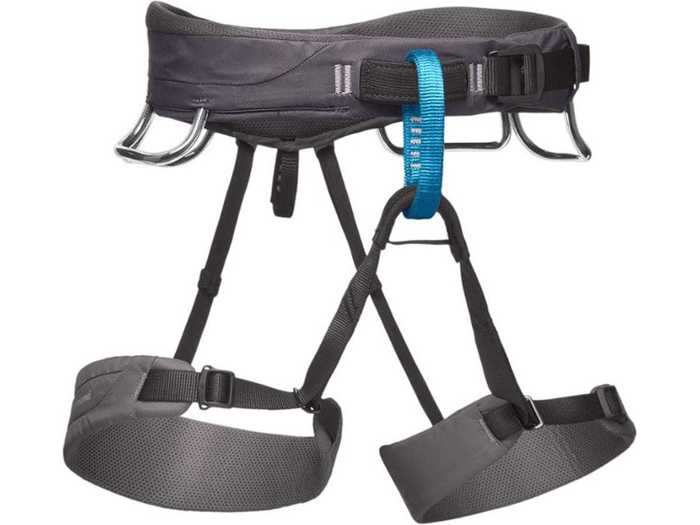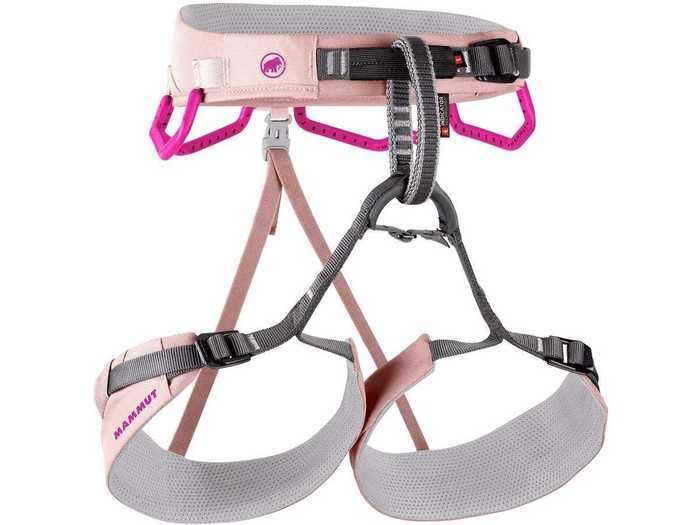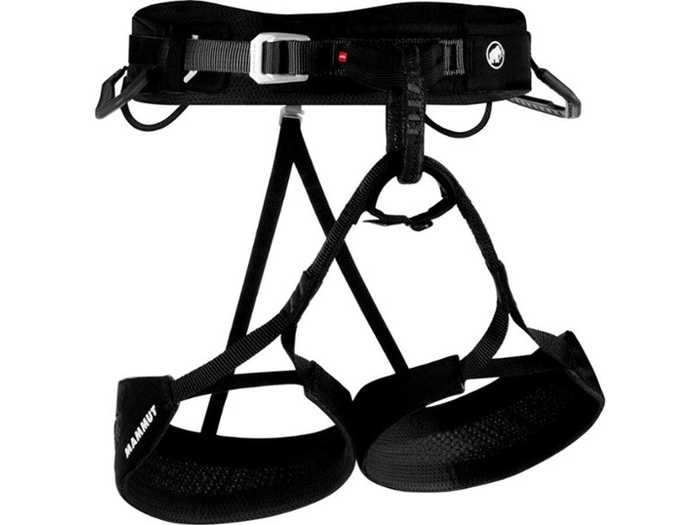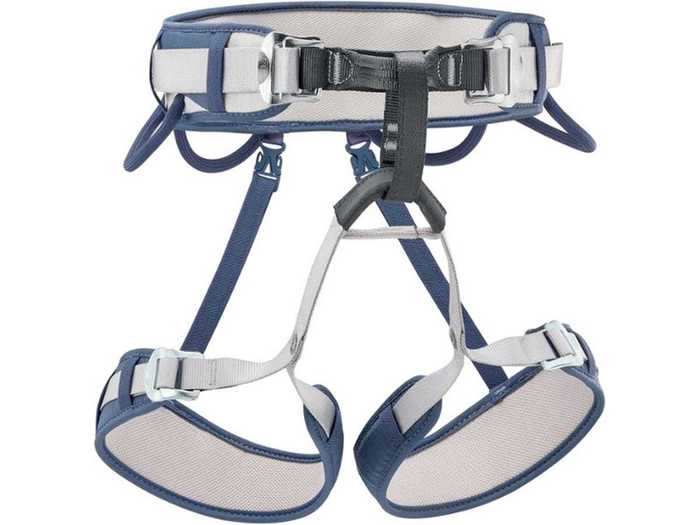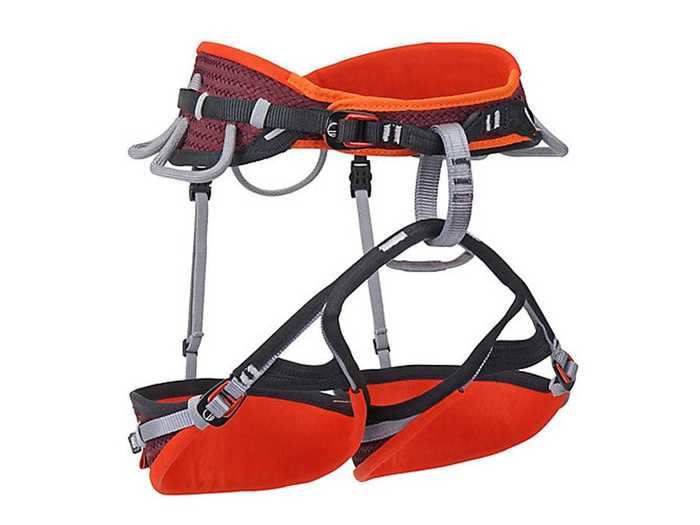When you buy through our links, we may earn money from our affiliate partners. Learn more.
- Since the release of films like "Free Solo," more people have started to get into the sport of climbing either as a hobby or a unique way to stay active and build upper body strength.
- Most indoor gyms provide rentals on shoes and harnesses but if you're serious about the sport, it's wise to purchase a bundle for yourself.
- If you plan on climbing more often, be it at a gym or outside, a harness is the first significant purchase you'll want to make.
- Our top pick, the Wild Country Mission, is comfortable to wear for long climbs, has room enough for plenty of gear, and costs less than $80, making it one of the finest beginner climbing harnesses available.
When you first start climbing, whether indoor or outdoor, you'll likely opt to rent your gear before buying. Between a pair of climbing shoes, a harness, or even a chalk bag from the gym, it's natural to go the rental route before investing in your own gear. It's smart to get a feel for what you do or don't like.
But once you do graduate from the ranks of rentals, the most important upgrade is your own personal harness. Though a standard gym harness gets the job done (and is often quite safe) the market is full of options that are lighter, more adjustable, and just much more comfortable than the gear found at most gyms.
What to look for in a harness
Before purchasing your first climbing kit, it's important to know what you're looking for. All harnesses have a waist belt and leg loops, as well as belay loop and two tie-in loops — the former for belaying and the latter for climbing. Leg and waist belts should be adjustable and well-padded enough so as to not bite into your legs and waist. Most harnesses also come in sizes, so be sure to double-check waist and leg measurements.
When shopping for a harness, consider what you want to do with it. If you intend to climb outside, you'll need gear loops on the belt of the harness to hold your rack, otherwise known as the equipment you carry to protect yourself from falling. Most harnesses have four individual loops, though it is possible to find those that have more. If you go the ultralight route, these harnesses come standard with fewer.
Another consideration is a drop-seat harness. These feature removable leg loops that stay tied into the harness for long alpine routes. Sport or gym harnesses are often stripped down, light, and have fewer gear loops. Trad harnesses have more gear space and often come with more padding. Alpine harnesses offer fewer gear loops but typically carry a pack. They also tend to be thinner and more packable for when you're not wearing it.
Once you have an idea of the kind of climbing you intend to do, then you can focus on the specific harness that's best. To help, we've tested a handful of beginner climbing harnesses from brands like Black Diamond, Petzl, and Mammut to find the best currently available.
Here are our picks for the best beginner climbing harnesses:
- Best overall: Wild Country Mission
- Best harness for beginners: Petzl Corax
- Best harness for an indoor gym: Mammut Alnasca
- Best all-around women's harness: Mammut Togir 3
- Best upgraded harness for new climbers: Black Diamond Momentum
Updated on 5/5/2020 by Rick Stella: Added a section on what to look for in a climbing harness in the introduction, updated the copy on each of the selected harnesses, updated the images, checked the availability of each pick, and updated the formatting, links, and prices.
Read the original article on
Business Insider
The best upgraded harness for new climbers
REI
Black Diamond's Momentum is robust, comfortable, and a huge upgrade from any rental at the gym.
It's easy to write off the Black Diamond Momentum as a simple beginner harness. Sure, it comes as part of a bundle with a chalk bag and a belay device, two extras that make it perfect for first-time harness buyers, but it's fully capable of sending big routes and long days outside. It can even hold its own transitioning from 5.7 to 5.10 in the gym.
Though its bulky waistband isn't exactly light, it is comfortable and uses two strips of webbing at the top and bottom to disperse the load. The leg loops are simple and easy to adjust and feel comfortable in shorts for the gym, as well as in more robust gear for outdoor and cold weather climbing.
The waist belt did run up a bit while hanging, though this was likely due to the fact I'm on the small side of medium. However, the padding on the waist and leg straps meant the Momentum was pleasant to hang in for long periods. I recommend sizing up if you feel you're between two sizes.
There are four well-placed and easily accessible gear loops, each covered in plastic to ensure gear's able to come off quickly. The four loops might not be enough for longer routes but I found them to be sufficient for sport climbs.
If you want to transition from a gym harness to something more comfortable, lighter in weight, and great for beginning sport climbing, the Momentum is your harness. Climbers who struggle to adjust their own leg loops will love the innovative buckle system on the Momentum and any climber will appreciate its great value.
Pros: Easily adjustable leg loops, great value
Cons: Not enough gear loops for long trad routes
The best all-around women's harness
Backcountry
The Mammut Togir 3 Slide is a great all-around harness with excellent fit in both women's and men's variants. The Togir 3 Slide is a feature-rich harness that's a great all-around option for climbers of any discipline. The buckles on the waist and legs easily adjust for use inside in shorts or when used over layers outside. There's a drop-seat buckle for longer routes, four reinforced and easy access gear loops, ice clipper attachments, and a reinforced pair of tie-in loops.
Though the feature list may be long for those climbing top rope routes in the gym, you'll still appreciate its mobility and light weight. My wife, who is just over five feet tall, found the harness to be comfortable on both long belays and sport routes. She also tends to use it for the gym where she appreciates the comfy waist strap and the belt-like loops for tucking in the waist strap to keep it out of the way.
The plastic molding around the tie-in loops is a great piece of design that helps prevent wear while also doing a great job of keeping the rope centered. This helps even out the load and reduces any chance of failure — it also makes falls a bit less painful.
If you climb long trad routes or carry a larger rack, you might find the four gear loops insufficient. The harness isn't as light as sport climbing harnesses but it is much more durable and practical than most superlight models. If you want just one harness and aren't sure what kind of climber you want to be, the Togir Slide is a great choice.
Pros: Nice fit, easily accessible gear loops
Cons: Some climbers found the gear loops to be too recessed
The best gym and sport climbing harness
REI
This light and comfy
harness from Mammut performs with the best sport competition harnesses but is plenty comfortable enough for long days at the crag.
The first thing you'll notice when you pick up Mammut's Alnasca is how light it is. This isn't a harness for trad multi-pitch routes but rather for gym and single pitch sport routes when you want to pack light and travel fast.
Unlike other lightweight harnesses, this one doesn't lack comfort. The lightweight and breathable waist and chest bands don't cut into your legs or waist thanks to its clever use of a laminate material which evenly distributes pressure on contact points.
A simple one buckle waist strap and elasticated leg loops allow it to go on easily and the two stable gear loops provide enough real estate for sport climbing quickdraws. There are also two smaller loops for longer routes. There's a coating on the tie-in loops that prevents wear and a simple stitched belay loop that stood up to months of use. I find the harness to be extremely comfortable on belay and it's become my go-to for gym climbing and shorter sports routes.
At under 300g, the Alnasca isn't going to hold you back on the approach or climb, and sport climbers will appreciate the barely-there feel it offers. The Alnasca harness also interfaces directly with the Alnasca chalk bag, without the need to use a carabiner or waist loop — which is a great way to save weight. Overall, the system is well designed and if it weren't nearly twice the price of others on this list, it would be my number one pick
Pros: Comfy, light, quick to put on and off
Cons: Expensive
The best climbing harness for beginners
REI
Petzl's
Corax is comfortable, adjustable, durable, and has plenty of gear storage. It delivers everything we want from a harness at a great price.
My favorite aspect of Petzl's Corax is that I don't have to think too much about it. I pull it on, adjust the waist and leg straps, clip-on my sport rack, and get on with climbing. It's that easy and one of the main reasons I keep grabbing it for quick sport climbs.
It's also far from the most expensive harness on this list — or the lightest, for that matter. But if you're not hauling gear up long approaches, the extra 200g won't hurt all that much. The two rigid and flexible gear loops carry plenty of gear on sport climbs and there's also a haul loop on the back to carry ice screws, a chalk bag, or an extra rope. The rigidity of the front loops makes it easy to clip gear on and off, too.
The double waist buckles mean the harness always sits centered on your waist and this, combined with the well-padded waistband, makes the Corax a great pick for comfort — especially for larger climbers.
I did find the leg loops to be uncomfortable on long top-rope belays but given the great value of this harness, I can't complain. Petzl also offers the Corax with a belay device, chalk bag, chalk, and locking carabiner. This should provide everything a beginner needs to get started aside from shoes.
Pros: Adjustable and comfortable, great value
Cons: Some leg strap issues on belay
The best climbing harness overall
Moosejaw
The
Mission harness from Wild Country has space for loads of gear, features comfortable waist and leg bands, and still costs under $80.
The harness packs five individual gear loops, a haul loop for pulling another rope, and accessory loops for ice screws, meaning it can grow as you grow as a climber. It's also comfortable, light, and easily adjustable for the gym. Should you progress to trad, sport, or ice climbing, it's still a suitable option.
The Mission uses lightweight 12mm and 16mm webbing, along with well-padded waist and leg loops. I found it comfortable to hang and fall on, and it's able to haul plenty of gear. I did find the leg loops for the medium size to be slightly large for my legs but leg loops don't always need to be extremely tight on harnesses.
The buckles can be a bit tough to use, especially in gloves but they do allow for a wide range of adjustments. The waist and leg straps don't fold or pressure point on any one area, which is welcome on hanging belays when your weight is placed directly on them. The gear loops on the harness are also well-placed, allowing you to avoid reaching very far back for draws.
Wild Country used Dura Weave fabric in the harness that's both flexible and durable despite my attempts to grate it against Joshua Tree's most abrasive chimneys. I also found it very breathable, even during triple-digit days in the desert. A lower back sweat patch often develops when I climb, though I found this to not always be the case with the Mission.
Overall, the wide waistband and breathable construction made this my go-to harness. I keep a lighter harness for the gym but in my outdoor climbing bag, the Mission lives with my rack, rope, helmet, and snacks. I'm often picky about climbing gear, so the fact this harness worked its way into my bag so quickly — and remained there so long — is high praise. Wild Country may best be known for its protective gear but this harness is a great buy.
Pros: Comfortable, light, breathable
Cons: Tough to use straps (especially when wearing gloves)

